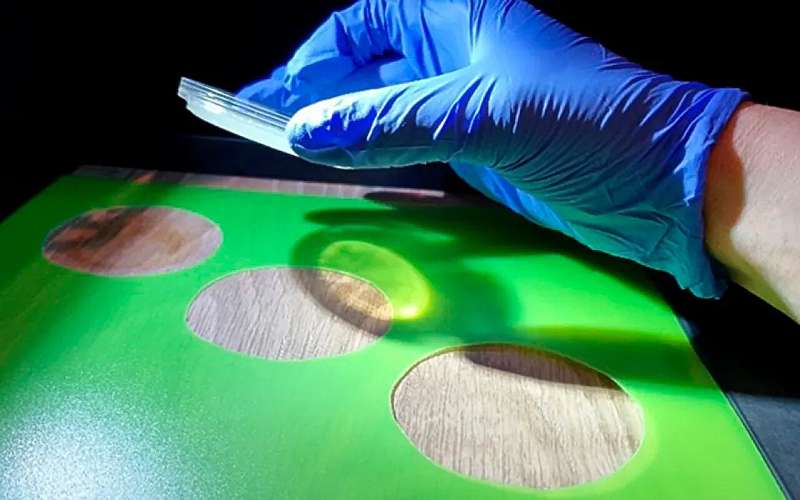This article has been reviewed according to Science X's editorial process and policies. Editors have highlighted the following attributes while ensuring the content's credibility:
fact-checked
trusted source
proofread
Investigating the effects of surface treatment on the antibacterial activity of wood

Research indicates that several pathogenic bacteria can remain contagious on a range of surfaces from hours to days and weeks. While wood as a surface material is known for its antibacterial properties, dry contamination via hands has so far been poorly understood, as most prior research has involved adding bacteria in liquid droplets to materials.
Researchers from the University of Helsinki, Natural Resources Institute Finland (Luke) and the University of Eastern Finland investigated the effects of surface treatment on the antibacterial activity of wood. In addition, they examined the antibacterial properties of 18 different surface materials commonly used indoors. These surfaces were exposed to bacteria that in real life are transmitted by dry hands, after which bacteria quantities were investigated in the laboratory.
The findings are published in the journal Environmental Advances.
"The least bacterial growth was observed on the surfaces of smooth materials, such as tile, laminate, vinyl cork and lacquer-coated wood. On untreated and, consequently, porous wooden surfaces, there was slightly more growth. However, variation was seen between different tree species: the lowest number of bacterial colonies was recorded on white oak and black walnut. The study encompassed commercial tree species from Finland, the United States and Japan," says Associate Professor Tuula Jyske from the University of Helsinki.
In addition, the study focused on the viability of the bacteria Staphylococcus epidermidis and Bacillus aerius/licheniformis, found commonly on the skin, on a range of materials. Staphylococcus epidermidis causes staphylococcus infections. In the study, B. aerius/licheniformis represented a bacterial strain producing dormant spores, which was expected to retain viability on surfaces better than sporeless bacteria. The tests were carried out in a controlled manner in an exposure chamber following the application of bacterial aerosols.
The experiments demonstrated that the viability of S. epidermidis, which occurs on the skin, was reduced on almost all of the surfaces studied. Untreated oak had the most negative effect on the viability of the bacteria; in contrast, the number of B. aerius/licheniformis colonies remained the same in most materials.
The study shows that the manifestation of the antibacterial properties of wood depends in many ways on the quality and conditions of the contamination.
"In moist conditions, the structure of porous wooden has the capacity to dry out bacteria, while in dry conditions bacteria are able to spread via hands more effectively to porous surfaces than to non-porous surfaces. In both cases, the chemical constituents of wood significantly limit bacterial growth," Jyske says.
Based on the findings that bacterial contamination via dry hands prevailed less than expected, treated wood should increasingly be used as surface material. The desired hygienic properties of wooden surfaces can be influenced by surface treatment and by favoring certain tree species.
"We will certainly see more pandemics down the line, which makes preventing contamination via surfaces important. And lacquer-coated wood still looks like wood, which is why its restorative effects related to well-being remain unchanged," Jyske notes.
More information: Kettunen Elina et al, Touch the wood: Antimicrobial properties of wooden and other solid material surfaces differ between dry and moist contamination in public and laboratory exposure, Environmental Advances (2023). DOI: 10.1016/j.envadv.2023.100416
Provided by University of Helsinki





















